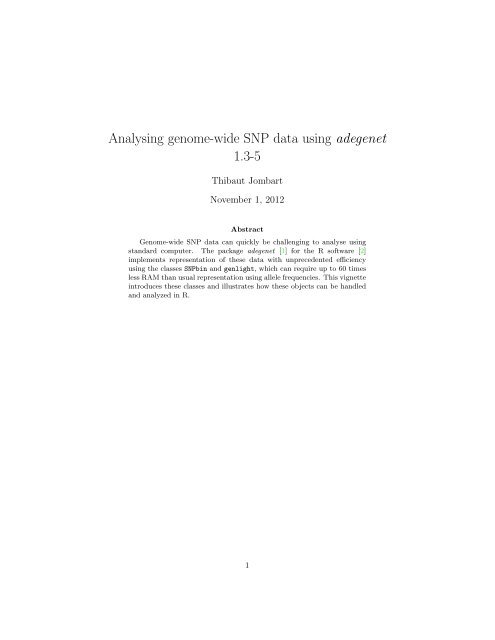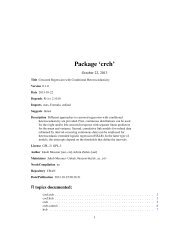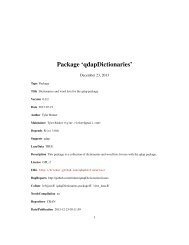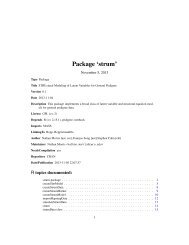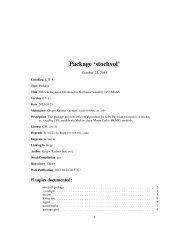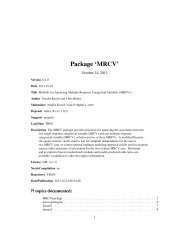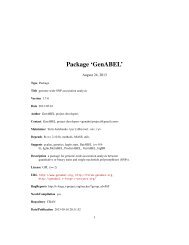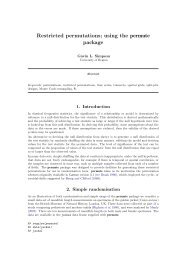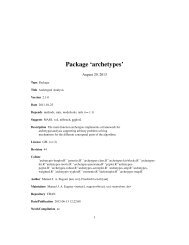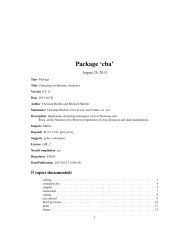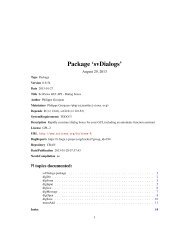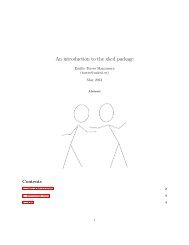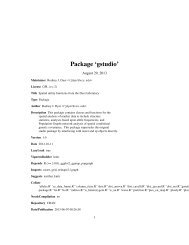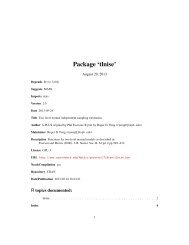Analysing genome-wide SNP data using adegenet 1.3-5
Analysing genome-wide SNP data using adegenet 1.3-5
Analysing genome-wide SNP data using adegenet 1.3-5
You also want an ePaper? Increase the reach of your titles
YUMPU automatically turns print PDFs into web optimized ePapers that Google loves.
<strong>Analysing</strong> <strong>genome</strong>-<strong>wide</strong> <strong>SNP</strong> <strong>data</strong> <strong>using</strong> <strong>adegenet</strong><br />
<strong>1.3</strong>-5<br />
Thibaut Jombart<br />
November 1, 2012<br />
Abstract<br />
Genome-<strong>wide</strong> <strong>SNP</strong> <strong>data</strong> can quickly be challenging to analyse <strong>using</strong><br />
standard computer. The package <strong>adegenet</strong> [1] for the R software [2]<br />
implements representation of these <strong>data</strong> with unprecedented efficiency<br />
<strong>using</strong> the classes <strong>SNP</strong>bin and genlight, which can require up to 60 times<br />
less RAM than usual representation <strong>using</strong> allele frequencies. This vignette<br />
introduces these classes and illustrates how these objects can be handled<br />
and analyzed in R.<br />
1
Contents<br />
1 Introduction 3<br />
2 Classes of objects 3<br />
2.1 <strong>SNP</strong>bin: storage of single <strong>genome</strong>s . . . . . . . . . . . . . . . . . 3<br />
2.2 genlight: storage of multiple <strong>genome</strong>s . . . . . . . . . . . . . . . 6<br />
3 Data handling <strong>using</strong> genlight objects 8<br />
3.1 Using accessors . . . . . . . . . . . . . . . . . . . . . . . . . . . . 8<br />
3.2 Subsetting the <strong>data</strong> . . . . . . . . . . . . . . . . . . . . . . . . . . 11<br />
3.3 Data conversions . . . . . . . . . . . . . . . . . . . . . . . . . . . 13<br />
3.3.1 The .snp format . . . . . . . . . . . . . . . . . . . . . . . 13<br />
3.3.2 Importing <strong>data</strong> from PLINK . . . . . . . . . . . . . . . . 16<br />
3.3.3 Extracting <strong>SNP</strong>s from alignments . . . . . . . . . . . . . . 16<br />
4 Data analysis <strong>using</strong> genlight objects 19<br />
4.1 Basic analyses . . . . . . . . . . . . . . . . . . . . . . . . . . . . . 20<br />
4.1.1 Plotting genlight objects . . . . . . . . . . . . . . . . . . 20<br />
4.1.2 genlight-optimized routines . . . . . . . . . . . . . . . . 22<br />
4.<strong>1.3</strong> <strong>Analysing</strong> <strong>data</strong> per block . . . . . . . . . . . . . . . . . . 25<br />
4.1.4 What is the unit of observation? . . . . . . . . . . . . . . 27<br />
4.2 Principal Component Analysis (PCA) . . . . . . . . . . . . . . . 29<br />
4.3 Discriminant Analysis of Principal Components (DAPC) . . . . . 33<br />
2
1 Introduction<br />
Modern sequencing technologies now make complete <strong>genome</strong>s more <strong>wide</strong>ly<br />
accessible. The subsequent amounts of genetic <strong>data</strong> pose challenges in terms<br />
of storing and handling the <strong>data</strong>, making former tools developed for classical<br />
genetic markers such as microsatellite impracticable <strong>using</strong> standard computers.<br />
Adegenet has developed new object classes dedicated to handling <strong>genome</strong><strong>wide</strong><br />
polymorphism (<strong>SNP</strong>s) with minimum random access memory (RAM)<br />
requirements.<br />
Two new formal classes have been implemented: <strong>SNP</strong>bin, used to store<br />
<strong>genome</strong>-<strong>wide</strong> <strong>SNP</strong>s for one individual, and genlight, which stored the same<br />
informationformultipleindividuals. Informationrepresentedthiswayisbinary:<br />
only biallelic <strong>SNP</strong>s can be stored and analyzed <strong>using</strong> these classes. However,<br />
these objects are otherwise very flexible, and can incorporate different levels of<br />
ploidy across individuals within a single <strong>data</strong>set. In this vignette, we present<br />
these object classes and show how their content can be further handled and<br />
content analyzed.<br />
2 Classes of objects<br />
2.1 <strong>SNP</strong>bin: storage of single <strong>genome</strong>s<br />
The class <strong>SNP</strong>bin is the core representation of biallelic <strong>SNP</strong>s which allows to<br />
represent <strong>data</strong> with unprecedented efficiency. The essential idea is to code<br />
binary <strong>SNP</strong>s not as integers, but as bits. This operation is tricky in R as there<br />
is no handling of bits, only bytes – series of 8 bits. However, the class <strong>SNP</strong>bin<br />
handles this transparently <strong>using</strong> sub-rountines in C language. Considerable<br />
efforts have been made so that the user does not have to dig into the complex<br />
internal structure of the objects, and can handle <strong>SNP</strong>bin objects as easily as<br />
possible.<br />
Likegenindandgenpopobjects,<strong>SNP</strong>binisaformal”S4”class. Thestructure<br />
of these objects is detailed in the dedicated manpage (?<strong>SNP</strong>bin). As all S4<br />
objects, instances of the class <strong>SNP</strong>bin are composed of slots accessible <strong>using</strong> the<br />
@ operator. This content is generic (it is the same for all instances of the class),<br />
and returned by:<br />
> library(<strong>adegenet</strong>)<br />
> getClassDef("<strong>SNP</strong>bin")<br />
Class "<strong>SNP</strong>bin" [package "<strong>adegenet</strong>"]<br />
Slots:<br />
Name: snp n.loc NA.posi label ploidy<br />
Class: list integer integer charOrNULL integer<br />
The slots respectively contain:<br />
3
• snp: <strong>SNP</strong> <strong>data</strong> with specific internal coding.<br />
• n.loc: the number of <strong>SNP</strong>s stored in the object.<br />
• NA.posi: position of the missing <strong>data</strong> (NAs).<br />
• label: an optional label for the individual.<br />
• ploidy: the ploidy level of the <strong>genome</strong>.<br />
New objects are created <strong>using</strong> new, with these slots as arguments. If no<br />
argument is provided, an empty object is created:<br />
> new("<strong>SNP</strong>bin")<br />
=== S4 class <strong>SNP</strong>bin ===<br />
0 <strong>SNP</strong>s coded as bits<br />
Ploidy: 1<br />
0 (NaN %) missing <strong>data</strong><br />
In practice, only thesnp information and possibly the ploidy has to be provided;<br />
various formats are accepted for the snp component, but the simplest is a vector<br />
of integers (or numeric) indicating the number of second allele at each locus.<br />
The argument snp, if provided alone, does not have to be named:<br />
> x x<br />
=== S4 class <strong>SNP</strong>bin ===<br />
7 <strong>SNP</strong>s coded as bits<br />
Ploidy: 2<br />
0 (0 %) missing <strong>data</strong><br />
If not provided, the ploidy is detected from the <strong>data</strong> and determined as the<br />
largest number in the input vector. Obviously, in many cases this will not be<br />
adequate, but ploidy can always be rectified afterwards; for instance:<br />
> x<br />
=== S4 class <strong>SNP</strong>bin ===<br />
7 <strong>SNP</strong>s coded as bits<br />
Ploidy: 2<br />
0 (0 %) missing <strong>data</strong><br />
> ploidy(x) x<br />
=== S4 class <strong>SNP</strong>bin ===<br />
7 <strong>SNP</strong>s coded as bits<br />
Ploidy: 3<br />
0 (0 %) missing <strong>data</strong><br />
The internal coding of the objects is cryptic, and not meant to be accessed<br />
directly:<br />
> x@snp<br />
4
[[1]]<br />
[1] 08<br />
[[2]]<br />
[1] 4e<br />
Fortunately, <strong>data</strong> are easily converted back into integers:<br />
> as.integer(x)<br />
[1] 0 1 1 2 0 0 1<br />
˜<br />
The main interest of this representation is its efficiency in terms of storage.<br />
For instance:<br />
> dat print(object.size(dat),unit="auto")<br />
[1] 4000040<br />
> x print(object.size(x),unit="auto")<br />
[1] 126320<br />
here, we converted a million <strong>SNP</strong>s into a <strong>SNP</strong>bin object, which turns out to be<br />
32 smaller than the original <strong>data</strong>. However, the information in dat and x is<br />
strictly identical:<br />
> identical(as.integer(x),dat)<br />
[1] FALSE<br />
The advantage of this storage is therefore being extremely compact, and<br />
allowing to analyse big <strong>data</strong>sets <strong>using</strong> standard computers.<br />
While <strong>SNP</strong>bin objects are the very mean by which we store <strong>data</strong> efficiently,<br />
in practice we need to analyze several <strong>genome</strong>s at a time. This is made possible<br />
by the class genlight, which relies on <strong>SNP</strong>bin but allows for storing <strong>data</strong> from<br />
several <strong>genome</strong>s at a time.<br />
5
2.2 genlight: storage of multiple <strong>genome</strong>s<br />
Like <strong>SNP</strong>bin, genlight is a formal S4 class. The slots of instances of this class<br />
are described by:<br />
> getClassDef("genlight")<br />
Class "genlight" [package "<strong>adegenet</strong>"]<br />
Slots:<br />
Name: gen n.loc ind.names loc.names loc.all<br />
Class: list integer charOrNULL charOrNULL charOrNULL<br />
Name: chromosome position ploidy pop other<br />
Class: factorOrNULL intOrNULL intOrNULL factorOrNULL list<br />
As it can be seen, these objects allow for storing more information in addition<br />
to vectors of <strong>SNP</strong> frequencies. More precisely, their content is (see ?genlight<br />
for more details):<br />
• gen: <strong>SNP</strong> <strong>data</strong> for different individuals, each stored as a <strong>SNP</strong>bin; loci have<br />
to be identical across all individuals.<br />
• n.loc: the number of <strong>SNP</strong>s stored in the object.<br />
• ind.names: (optional) labels for the individuals.<br />
• loc.names: (optional) labels for the loci.<br />
• loc.all: (optional) alleles of the loci separated by ’/’ (e.g. ’a/t’, ’g/c’,<br />
etc.).<br />
• chromosome: (optional) a factor indicating the chromosome to which the<br />
<strong>SNP</strong>s belong.<br />
• position: (optional) the position of each <strong>SNP</strong>s in their chromosome.<br />
• ploidy: (optional) the ploidy of each individual.<br />
• pop: (optional) a factor grouping individuals into ’populations’.<br />
• other: (optional) a list containing any supplementary information to be<br />
stored with the <strong>data</strong>.<br />
Like <strong>SNP</strong>bin object, genlight object are created <strong>using</strong> the constructor new,<br />
providing content for the slots above as arguments. When none is provided, an<br />
empty object is created:<br />
> new("genlight")<br />
=== S4 class genlight ===<br />
0 genotypes, 0 binary <strong>SNP</strong>s<br />
The most important information to provide is obviously the genotypes<br />
(argument gen); these can be provided as:<br />
6
• a list of integer vectors representing the number of second allele at each<br />
locus.<br />
• a matrix / <strong>data</strong>.frame of integers, with individuals in rows and <strong>SNP</strong>s in<br />
columns.<br />
• a list of <strong>SNP</strong>bin objects.<br />
Ploidy has to be consistent across loci for a given individual, but individuals<br />
donothavetohavethesameploidy, sothatitispossibletohavehapoid, diploid,<br />
and tetraploid individuals in the same <strong>data</strong>set; for instance:<br />
> x x<br />
=== S4 class genlight ===<br />
3 genotypes, 6 binary <strong>SNP</strong>s<br />
Ploidy statistics (min/median/max): 1 / 2 / 4<br />
0 (0 %) missing <strong>data</strong><br />
> ploidy(x)<br />
indiv1 indiv2 toto<br />
1 2 4<br />
As for <strong>SNP</strong>bin, genlight objects can be converted back to integers vectors,<br />
stored as matrices or lists:<br />
> as.list(x)<br />
$indiv1<br />
[1] 1 1 0 1 1 0<br />
$indiv2<br />
[1] 2 1 1 0 0 0<br />
$toto<br />
[1] 2 2 0 0 4 4<br />
> as.matrix(x)<br />
[,1] [,2] [,3] [,4] [,5] [,6]<br />
indiv1 1 1 0 1 1 0<br />
indiv2 2 1 1 0 0 0<br />
toto 2 2 0 0 4 4<br />
In practice, genlight objects can be handled as if they were matrices of integers<br />
as the one above returned by as.matrix. However, they offer the advantage of<br />
efficient storage of the information; for instance, we can simulate 50 individuals<br />
typed for 100,000 <strong>SNP</strong>s each (including occasional NAs):<br />
> dat names(dat) print(object.size(dat),unit="auto")<br />
7
[1] 40005720<br />
> x print(object.size(x),unit="auto")<br />
[1] 716528<br />
> object.size(dat)/object.size(x)<br />
55.8327378692808 bytes<br />
here again, the storage if the <strong>data</strong> is much more efficient in genlight than<br />
<strong>using</strong> integers: converted <strong>data</strong> occupy 56 times less memory than the original<br />
<strong>data</strong>.<br />
The advantage of this storage is therefore being extremely compact, and<br />
allowing to analyse very large <strong>data</strong>sets <strong>using</strong> standard computers. Obviously,<br />
usual computations demand <strong>data</strong> to be at one moment coded as numeric values<br />
(as opposed to bits). However, most usual computations can be achieved<br />
by only converting one or two <strong>genome</strong>s back to numeric values at a time,<br />
therefore keeping RAM requirements low, albeit at a possible cost of increased<br />
computational time. This however is minimized by three ways:<br />
1. conversion routines are optimized for speed <strong>using</strong> C code.<br />
2. <strong>using</strong> parallel computation where multicore architectures are available.<br />
3. handling smaller objects, thereby decreasing the possibly high<br />
computational time taken by memory allocation.<br />
While this makes implementing methods more complicated. In practice,<br />
routines are implemented so as to minimize the amount of <strong>data</strong> converted<br />
back to integers, use C code where possible, and use multiple cores if the<br />
package multicore is installed an multiple cores are available. Fortunately, these<br />
underlying technical issues are oblivious to the user, and one merely needs to<br />
know how to manipulate genlight objects <strong>using</strong> a few key functions to be able<br />
to analyze <strong>data</strong>.<br />
3 Data handling <strong>using</strong> genlight objects<br />
3.1 Using accessors<br />
In the following, we demonstrate how to manipulate and analyse genlight<br />
objects. The phylosophy underlying formal (S4) classes in general, and<br />
genlightobjectsinparticular, isthatinternalrepresentationoftheinformation<br />
8
can be complex as long as accessing this information is simple. This is made<br />
possible by decoupling storage and accession: the user is not meant to access<br />
the content of the object directly, but has to use accessors to retrieve or<br />
modify information.<br />
Available accessors are documented in ?genlight. Most of them are<br />
identical to accessors for genind and genpop objects, such as:<br />
• nInd: returns the number of individuals in the object.<br />
• nLoc: returns the number of loci (<strong>SNP</strong>s).<br />
• indNames † : returns/sets labels for individuals.<br />
• locNames † : returns/sets labels for loci (<strong>SNP</strong>s).<br />
• alleles † : returns/sets alleles.<br />
• ploidy † : returns/sets ploidy of the individuals.<br />
• pop † : returns/sets a factor grouping individuals.<br />
• other † : returns/sets misc information stored as a list.<br />
where † indicates that a replacement method is available <strong>using</strong> dat dat<br />
[[1]]<br />
[1] 1 1 0 2 0 0 1 0 2 2<br />
[[2]]<br />
[1] 1 0 1 0 0 2 1 0 0 0<br />
[[3]]<br />
[1] 1 1 1 0 1 2 2 2 0 1<br />
> x x<br />
=== S4 class genlight ===<br />
3 genotypes, 10 binary <strong>SNP</strong>s<br />
Ploidy: 2<br />
0 (0 %) missing <strong>data</strong><br />
> indNames(x)<br />
NULL<br />
> indNames(x) indNames(x)<br />
[1] "individual 1" "individual 2" "individual 3"<br />
9
locNames(x)<br />
> locNames(x) as.matrix(x)<br />
<strong>SNP</strong>.1 <strong>SNP</strong>.2 <strong>SNP</strong>.3 <strong>SNP</strong>.4 <strong>SNP</strong>.5 <strong>SNP</strong>.6 <strong>SNP</strong>.7 <strong>SNP</strong>.8 <strong>SNP</strong>.9 <strong>SNP</strong>.10<br />
individual 1 1 1 0 2 0 0 1 0 2 2<br />
individual 2 1 0 1 0 0 2 1 0 0 0<br />
individual 3 1 1 1 0 1 2 2 2 0 1<br />
In addition, some specific accessors are available for genlight objects:<br />
• NA.posi: returns the position of missing values in each individual.<br />
• chromosome † : returns/sets the chromosome of each <strong>SNP</strong>.<br />
• chr † : same as chromosome — used as a shortcut.<br />
• position † : returns/sets the position of each <strong>SNP</strong>.<br />
Accessors are meant to be clever about replacement, meaning that they try<br />
hard to prevent replacement with inconsistent values. For instance, in object x:<br />
> x<br />
=== S4 class genlight ===<br />
3 genotypes, 10 binary <strong>SNP</strong>s<br />
Ploidy: 2<br />
0 (0 %) missing <strong>data</strong><br />
@loc.names: labels of the <strong>SNP</strong>s<br />
if we try to set information about the chromosomes of the <strong>SNP</strong>s, the instruction:<br />
> chr(x) chr(x) x<br />
=== S4 class genlight ===<br />
3 genotypes, 10 binary <strong>SNP</strong>s<br />
Ploidy: 2<br />
0 (0 %) missing <strong>data</strong><br />
@chromosome: chromosome of the <strong>SNP</strong>s<br />
@loc.names: labels of the <strong>SNP</strong>s<br />
> chr(x)<br />
[1] chr-1 chr-1 chr-1 chr-1 chr-1 chr-1 chr-1 chr-1 chr-1 chr-1<br />
Levels: chr-1<br />
is a valid replacement.<br />
10
3.2 Subsetting the <strong>data</strong><br />
genlight objects are meant to be handled as if they were matrices of allele<br />
numbers, as returned by as.matrix. Therefore, subsetting can be achieved<br />
<strong>using</strong> [ idx.row , idx.col ] where idx.row and idx.col are indices for rows<br />
(individuals) and columns (<strong>SNP</strong>s). For instance, <strong>using</strong> the previous toy <strong>data</strong>set,<br />
we try a few classical subsetting of rows and columns:<br />
> x<br />
=== S4 class genlight ===<br />
3 genotypes, 10 binary <strong>SNP</strong>s<br />
Ploidy: 2<br />
0 (0 %) missing <strong>data</strong><br />
@chromosome: chromosome of the <strong>SNP</strong>s<br />
@loc.names: labels of the <strong>SNP</strong>s<br />
> as.matrix(x)<br />
<strong>SNP</strong>.1 <strong>SNP</strong>.2 <strong>SNP</strong>.3 <strong>SNP</strong>.4 <strong>SNP</strong>.5 <strong>SNP</strong>.6 <strong>SNP</strong>.7 <strong>SNP</strong>.8 <strong>SNP</strong>.9 <strong>SNP</strong>.10<br />
individual 1 1 1 0 2 0 0 1 0 2 2<br />
individual 2 1 0 1 0 0 2 1 0 0 0<br />
individual 3 1 1 1 0 1 2 2 2 0 1<br />
> as.matrix(x[c(1,3),])<br />
<strong>SNP</strong>.1 <strong>SNP</strong>.2 <strong>SNP</strong>.3 <strong>SNP</strong>.4 <strong>SNP</strong>.5 <strong>SNP</strong>.6 <strong>SNP</strong>.7 <strong>SNP</strong>.8 <strong>SNP</strong>.9 <strong>SNP</strong>.10<br />
individual 1 1 1 0 2 0 0 1 0 2 2<br />
individual 3 1 1 1 0 1 2 2 2 0 1<br />
> as.matrix(x[, c(TRUE,FALSE)])<br />
<strong>SNP</strong>.1 <strong>SNP</strong>.3 <strong>SNP</strong>.5 <strong>SNP</strong>.7 <strong>SNP</strong>.9<br />
individual 1 1 0 0 1 2<br />
individual 2 1 1 0 1 0<br />
individual 3 1 1 1 2 0<br />
> as.matrix(x[1:2, c(1,1,1,2,2,2,3,3,3)])<br />
<strong>SNP</strong>.1 <strong>SNP</strong>.1 <strong>SNP</strong>.1 <strong>SNP</strong>.2 <strong>SNP</strong>.2 <strong>SNP</strong>.2 <strong>SNP</strong>.3 <strong>SNP</strong>.3 <strong>SNP</strong>.3<br />
individual 1 1 1 1 1 1 1 0 0 0<br />
individual 2 1 1 1 0 0 0 1 1 1<br />
Moreover, one can split <strong>data</strong> into blocks of <strong>SNP</strong>s <strong>using</strong> seploc. This can be<br />
achieved by specifying either a number of blocks (argument n.block) or the size<br />
of the blocks (argument block.size). The function also allows for randomizing<br />
the distribution of the <strong>SNP</strong>s in the blocks (argument random=TRUE), which<br />
is especially useful to replace computations that cannot be achieved on the<br />
whole <strong>data</strong>set with parallelized computations performed on random blocks (for<br />
parallelization, remove the argument multicore=FALSE). For instance:<br />
> x<br />
11
=== S4 class genlight ===<br />
3 genotypes, 10 binary <strong>SNP</strong>s<br />
Ploidy: 2<br />
0 (0 %) missing <strong>data</strong><br />
@chromosome: chromosome of the <strong>SNP</strong>s<br />
@loc.names: labels of the <strong>SNP</strong>s<br />
> as.matrix(x)<br />
<strong>SNP</strong>.1 <strong>SNP</strong>.2 <strong>SNP</strong>.3 <strong>SNP</strong>.4 <strong>SNP</strong>.5 <strong>SNP</strong>.6 <strong>SNP</strong>.7 <strong>SNP</strong>.8 <strong>SNP</strong>.9 <strong>SNP</strong>.10<br />
individual 1 1 1 0 2 0 0 1 0 2 2<br />
individual 2 1 0 1 0 0 2 1 0 0 0<br />
individual 3 1 1 1 0 1 2 2 2 0 1<br />
> seploc(x, n.block=2, multicore=FALSE)<br />
$block.1<br />
=== S4 class genlight ===<br />
3 genotypes, 5 binary <strong>SNP</strong>s<br />
Ploidy: 2<br />
0 (0 %) missing <strong>data</strong><br />
@chromosome: chromosome of the <strong>SNP</strong>s<br />
@loc.names: labels of the <strong>SNP</strong>s<br />
$block.2<br />
=== S4 class genlight ===<br />
3 genotypes, 5 binary <strong>SNP</strong>s<br />
Ploidy: 2<br />
0 (0 %) missing <strong>data</strong><br />
@chromosome: chromosome of the <strong>SNP</strong>s<br />
@loc.names: labels of the <strong>SNP</strong>s<br />
> lapply(seploc(x, n.block=2, multicore=FALSE),as.matrix)<br />
$block.1<br />
<strong>SNP</strong>.1 <strong>SNP</strong>.2 <strong>SNP</strong>.3 <strong>SNP</strong>.4 <strong>SNP</strong>.5<br />
individual 1 1 1 0 2 0<br />
individual 2 1 0 1 0 0<br />
individual 3 1 1 1 0 1<br />
$block.2<br />
<strong>SNP</strong>.6 <strong>SNP</strong>.7 <strong>SNP</strong>.8 <strong>SNP</strong>.9 <strong>SNP</strong>.10<br />
individual 1 0 1 0 2 2<br />
individual 2 2 1 0 0 0<br />
individual 3 2 2 2 0 1<br />
splits the <strong>data</strong> into two blocks of contiguous <strong>SNP</strong>s, while:<br />
> lapply(seploc(x, n.block=2, random=TRUE, multicore=FALSE),as.matrix)<br />
$block.1<br />
<strong>SNP</strong>.1 <strong>SNP</strong>.3 <strong>SNP</strong>.7 <strong>SNP</strong>.2 <strong>SNP</strong>.10<br />
individual 1 1 0 1 1 2<br />
individual 2 1 1 1 0 0<br />
individual 3 1 1 2 1 1<br />
$block.2<br />
<strong>SNP</strong>.9 <strong>SNP</strong>.4 <strong>SNP</strong>.6 <strong>SNP</strong>.8 <strong>SNP</strong>.5<br />
individual 1 2 2 0 0 0<br />
individual 2 0 0 2 0 0<br />
individual 3 0 0 2 2 1<br />
generates blocks of randomly selected <strong>SNP</strong>s.<br />
12
3.3 Data conversions<br />
3.3.1 The .snp format<br />
<strong>adegenet</strong> has defined its own format for storing biallelic <strong>SNP</strong> <strong>data</strong> in text files<br />
with extension .snp. This format has several advantages: it is fairly compact<br />
(more so than usual non-compressed formats), allows for any information about<br />
individuals or loci to be stored, allows for comments, and is easily parsed — in<br />
particular, not all information has to be read at a time, again minimizing RAM<br />
requirements for import procedures.<br />
Anexamplefileofthisformatisdistributedwith<strong>adegenet</strong>. Oncethepackage<br />
has been installed, the file can be accessed by typing:<br />
> file.show(system.file("files/exampleSnpDat.snp",package="<strong>adegenet</strong>"))<br />
Otherwise, this file is also accessible from the <strong>adegenet</strong> website (section<br />
’Documents’). A complete description of the .snp format is provided in the<br />
comment section of the file.<br />
The structure of a .snp file can be summarized as follows:<br />
• a (possibly empty) comment section<br />
• meta-information, i.e. information about loci or individuals, stored as<br />
named vectors<br />
• genotypes, stored as named vectors<br />
The comment section can starts with the line:<br />
>>>> begin comments - do not remove this line > end comments - do not remove this line
• population: character strings indicating a group memberships of the<br />
individuals<br />
• ploidy: integers indicating the ploidy of each individual; alternatively,<br />
one single integer if all individuals have the same ploidy<br />
• chromosome: character strings indicating the chromosome on which the<br />
<strong>SNP</strong> are located<br />
Each genotype is stored <strong>using</strong> two lines, the first being:<br />
> label-of-the-individual<br />
and the second being integers corresponding to the number of second allele for<br />
each loci, without separators; missing <strong>data</strong> are coded as ’-’.<br />
.snp files can be read in R <strong>using</strong> read.snp, which converts <strong>data</strong> into<br />
genlight objects. The function reads <strong>data</strong> by chunks of a several individuals<br />
(minimum 1, no maximum besides RAM constraints) at a time, which allows<br />
one to read massive <strong>data</strong>sets with negligible RAM requirements (albeit at a<br />
cost of computational time). The argument chunkSize indicates the number of<br />
<strong>genome</strong>s read at a time; larger values mean reading <strong>data</strong> faster but require more<br />
RAM. We can illustrate read.snp <strong>using</strong> the example file mentioned above. The<br />
non-comment part of the file reads:<br />
[...]<br />
>> position<br />
1 8 11 43<br />
>> allele<br />
a/t g/c a/c t/a<br />
>> population<br />
Brit Brit Fren monster NA<br />
>> ploidy<br />
2<br />
> foo<br />
1020<br />
> bar<br />
0012<br />
> toto<br />
10-0<br />
> Nyarlathotep<br />
0120<br />
> an even longer label but OK since on a single line<br />
1100<br />
We read the file in <strong>using</strong>:<br />
> obj
Reading biallelic <strong>SNP</strong> <strong>data</strong> file into a genlight object...<br />
Reading comments...<br />
Reading general information...<br />
Reading 5 genotypes...<br />
...<br />
Checking consistency...<br />
Building final object...<br />
...done.<br />
> obj<br />
=== S4 class genlight ===<br />
5 genotypes, 4 binary <strong>SNP</strong>s<br />
Ploidy: 2<br />
1 (0.05 %) missing <strong>data</strong><br />
@pop: individual membership for 4 populations<br />
@position: position of the <strong>SNP</strong>s<br />
@alleles: alleles of the <strong>SNP</strong>s<br />
> as.matrix(obj, multicore=FALSE)<br />
1.a/t 8.g/c 11.a/c 43.t/a<br />
foo 1 0 2 0<br />
bar 0 0 1 2<br />
toto 1 0 NA 0<br />
Nyarlathotep 0 1 2 0<br />
an even longer label but OK since on a single line 1 1 0 0<br />
> alleles(obj)<br />
[1] "a/t" "g/c" "a/c" "t/a"<br />
> pop(obj)<br />
[1] Brit Brit Fren monster NA<br />
Levels: Brit Fren NA monster<br />
> indNames(obj)<br />
[1] "foo"<br />
[2] "bar"<br />
[3] "toto"<br />
[4] "Nyarlathotep"<br />
[5] "an even longer label but OK since on a single line"<br />
Note that system.file is generally useless: it is only used in this example<br />
to access a file installed alongside the package. Usual calls to read.snp will<br />
ressemble:<br />
> obj
3.3.2 Importing <strong>data</strong> from PLINK<br />
Genome-<strong>wide</strong> <strong>SNP</strong> <strong>data</strong> of diploid organisms are frequently analyzed<br />
<strong>using</strong> PLINK, whose format is therefore becoming a standard. Data<br />
with PLINK format (.raw) can be imported into genlight objects<br />
<strong>using</strong> read.PLINK. This function requires the <strong>data</strong> to be saved in<br />
PLINK <strong>using</strong> the ‘-recodeA‘ option (see details section in ?read.PLINK).<br />
More information on exporting from PLINK can be found at http:<br />
//pngu.mgh.harvard.edu/~purcell/plink/<strong>data</strong>man.shtml#recode.<br />
Like read.snp, read.PLINK has the advantage of reading <strong>data</strong> by chunks<br />
of a few individuals (down to a single one at a time, no upper limits),<br />
which minimizes the amount of memory needed to read information before<br />
its conversion to genlight; however, <strong>using</strong> more chunks also means more<br />
computational time, since the procedure has to re-read the same file several<br />
time. Note that meta information about the loci also known as .map can also<br />
be read alongside a .raw file <strong>using</strong> the argument map.file. Alternatively,<br />
such information can be added to a genlight object afterwards <strong>using</strong><br />
extract.PLINKmap.<br />
3.3.3 Extracting <strong>SNP</strong>s from alignments<br />
In many cases, raw genomic <strong>data</strong> are available as aligned sequences, in which<br />
case extracting polymorphic sites can be non-trivial. The biggest issue is again<br />
memory: most software extracting <strong>SNP</strong>s from aligned sequences require all<br />
the sequences to be stored in memory at a time, a duty that most common<br />
computers cannot undertake. <strong>adegenet</strong> implements a more parsimonious<br />
alternative which allows for extracting <strong>SNP</strong>s from alignment while processing<br />
a reduced number of sequences (down to a single) at a time.<br />
The function fasta2genlight extracts <strong>SNP</strong>s from alignments with fasta<br />
format (file extensions ’.fasta’, ’.fas’, or ’.fa’). Like read.snp and<br />
read.PLINK, fasta2genlight processes <strong>data</strong> by chunks of individuals so as<br />
to save memory requirements. It first scans the whole file for polymorphic<br />
positions, and then extracts all biallelic <strong>SNP</strong>s from the alignment.<br />
fasta2genlight is illustrated like read.snp <strong>using</strong> a toy <strong>data</strong>set distributed<br />
alongside the package. The file is first located <strong>using</strong> system.file, and then<br />
processed <strong>using</strong> fasta2genlight:<br />
> myPath flu
Building final object...<br />
...done.<br />
> flu<br />
=== S4 class genlight ===<br />
80 genotypes, 274 binary <strong>SNP</strong>s<br />
Ploidy: 1<br />
26 (0 %) missing <strong>data</strong><br />
@position: position of the <strong>SNP</strong>s<br />
@alleles: alleles of the <strong>SNP</strong>s<br />
flu is a genlight object containing <strong>SNP</strong>s of 80 isolates of seasonal influenza<br />
(H3N2) sampled within the US over the last two decades; sequences correspond<br />
to the hemagglutinin (HA) segment. Besides genotypes, flu contains the<br />
positions of the <strong>SNP</strong>s and the alleles at each retained loci. Names of the loci<br />
are constructed as the combination of both:<br />
> head(position(flu), 20)<br />
[1] 7 12 31 32 36 37 44 45 52 60 62 72 73 78 96 99 105 108 121<br />
[20] 128<br />
> head(alleles(flu), 20)<br />
[1] "a/g" "c/t" "t/c" "t/c" "t/c" "c/a" "t/c" "c/t" "a/g" "c/t" "g/t" "c/a"<br />
[13] "a/g" "a/g" "a/g" "c/t" "a/g" "g/a" "c/a" "a/g"<br />
> head(locNames(flu), 20)<br />
[1] "7.a/g" "12.c/t" "31.t/c" "32.t/c" "36.t/c" "37.c/a" "44.t/c"<br />
[8] "45.c/t" "52.a/g" "60.c/t" "62.g/t" "72.c/a" "73.a/g" "78.a/g"<br />
[15] "96.a/g" "99.c/t" "105.a/g" "108.g/a" "121.c/a" "128.a/g"<br />
It is usually informative to assess the position of the polymorphic sites within<br />
the <strong>genome</strong>; this is very easily done in R, <strong>using</strong> density with an appropriate<br />
bandewidth:<br />
> temp plot(temp, type="n", xlab="Position in the alignment", main="Location of the <strong>SNP</strong>s",<br />
+ xlim=c(0,1701))<br />
> polygon(c(temp$x,rev(temp$x)), c(temp$y, rep(0,length(temp$x))), col=transp("blue",.3))<br />
> points(position(flu), rep(0, nLoc(flu)), pch="|", col="blue")<br />
17
Density<br />
0.0000 0.0005 0.0010 0.0015<br />
Location of the <strong>SNP</strong>s<br />
| ||||| ||||| |||||||| | || | || |||||| || ||| | |||| |||||||||| || ||||| | ||||||| ||| |||||||| |||| |||| ||<br />
0 500 1000 1500<br />
Position in the alignment<br />
In this case, <strong>SNP</strong>s are distributed fairly homogeneously across the HA segment,<br />
with a few possible hotspots of polymorphism within positions 400—700.<br />
Note that retaining only biallelic sites may cause minor loss of information,<br />
as sites with more than 2 alleles are discarded from the <strong>data</strong>. It is however<br />
possible to ask fasta2genlight to keep track of the number of alleles for each<br />
site of the original alignment, by specifying:<br />
> flu flu<br />
=== S4 class genlight ===<br />
80 genotypes, 274 binary <strong>SNP</strong>s<br />
Ploidy: 1<br />
26 (0 %) missing <strong>data</strong><br />
@position: position of the <strong>SNP</strong>s<br />
@alleles: alleles of the <strong>SNP</strong>s<br />
@other: a list containing: nb.all.per.loc<br />
The output object flu now contains the number of alleles of each position,<br />
stored in the other slot:<br />
> head(other(flu)$nb.all.per.loc, 20)<br />
[1] 1 1 1 1 1 1 2 1 1 1 1 2 1 1 1 1 1 1 1 1<br />
> 100*mean(unlist(other(flu))>1)<br />
18
[1] 17.81305<br />
About 18% of the sites are polymorphic, which is fairly high. This is not entirely<br />
surprising, giventhattheHAsegmentofinfluenzaisknownforitshighmutation<br />
rate. What is the nature of this polymorphism?<br />
> temp barplot(temp, main="Distribution of the number \nof alleles per loci",<br />
+ xlab="Number of alleles", ylab="Number of sites", col=heat.colors(4))<br />
Number of sites<br />
0 200 400 600 800 1000 1200<br />
Distribution of the number<br />
of alleles per loci<br />
1 2 3 4<br />
Number of alleles<br />
Most polymorphic loci are biallelic, but a few loci with 3 or 4 alleles were lost.<br />
We can estimate the loss of information very simply:<br />
> temp temp round(temp,1)<br />
2 3 4<br />
90.4 8.3 <strong>1.3</strong><br />
In this case, 90.4% of the polymorphic sites were biallelic, the others being<br />
essentially triallelic. This is probably a fairly exceptional situation due to the<br />
high mutation rate of the HA segment.<br />
4 Data analysis <strong>using</strong> genlight objects<br />
In the following, we illustrate some methods for the analysis of genlight<br />
objects, ranging from simple tools for diagnosing allele frequencies or missing<br />
19
<strong>data</strong> to recently developed multivariate approaches. Some examples below<br />
are illustrated <strong>using</strong> toy <strong>data</strong>sets generated <strong>using</strong> the function glSim. This<br />
simple simulation tool allows for simulating large <strong>SNP</strong>s <strong>data</strong> with possibly<br />
contrasted structures between two groups of individuals or patterns of linkage<br />
disequilibrium (LD). See ?glSim for more details on this tool.<br />
4.1 Basic analyses<br />
4.1.1 Plotting genlight objects<br />
Basic features of the <strong>data</strong> may also be inferred by simply looking at the <strong>data</strong>.<br />
genlight objects can be plotted <strong>using</strong> glPlot, or simply plot (both names<br />
actually correspond to the same function). This function displays the <strong>data</strong> as<br />
images, representing numbers of second alleles <strong>using</strong> colours. For instance, we<br />
can have a feel for the amount and location of missing <strong>data</strong> in the influenza<br />
<strong>data</strong>set (see previous section) fairly easily:<br />
> glPlot(flu, posi="topleft")<br />
The white streches in the first 30 <strong>SNP</strong>s observed around individual 70 indicate<br />
missing <strong>data</strong>. There are only a few missing <strong>data</strong>, and they only concern a<br />
couple of individuals.<br />
In some simple cases, some biological structures might also be apparent<br />
in such plot. For instance, we can generate <strong>data</strong> with independent <strong>SNP</strong>s<br />
distributions for two groups:<br />
> x plot(x)<br />
20
Strong patterns of LD between contiguous sites are also very easy to spot:<br />
> x plot(x)<br />
21
Of course, this is merely a very preliminary approach to the <strong>data</strong>. More<br />
detailed analysis can be achieved <strong>using</strong> both standard and ad hoc procedures as<br />
detailed below.<br />
4.1.2 genlight-optimized routines<br />
Some simple operations such as computing allele frequencies or diagnosing<br />
missing values can be problematic when the <strong>data</strong> matrix cannot be represented<br />
in memory. <strong>adegenet</strong> implements a few basic procedures which perform such<br />
basic tasks on genlight objects processing one individual at a time, thereby<br />
minimizing memory requirements. The most computer-intensive of these<br />
procedures can also use compiled C code and/or multicore capabilities (when<br />
available) to speed up computations.<br />
All these procedures are named <strong>using</strong> the prefix gl (for genlight), and can<br />
therefore be listed by typing gl and pressing the TAB key twice. They are (see<br />
?glMean):<br />
• glSum: computes the sum of second alleles for each <strong>SNP</strong>.<br />
• glNA: computes the number of missing values in each locus.<br />
• glMean: computes the mean of second alleles, i.e. second allele frequencies<br />
for each <strong>SNP</strong>.<br />
22
• glVar: computes the variance of the second allele frequency for each <strong>SNP</strong>.<br />
• glDotProd: computes the dot products between all pairs of individuals,<br />
with possible centring and scaling.<br />
For instance, one can easily derive the distributiong of allele frequencies <strong>using</strong>:<br />
> myFreq hist(myFreq, proba=TRUE, col="gold", xlab="Allele frequencies",<br />
+ main="Distribution of (second) allele frequencies")<br />
> temp lines(temp$x, temp$y*1.8,lwd=3)<br />
Density<br />
0 1 2 3 4 5 6<br />
Distribution of (second) allele frequencies<br />
0.0 0.2 0.4 0.6 0.8 1.0<br />
Allele frequencies<br />
In biallelic loci, one allele is always entirely redundant with the other, so it is<br />
generally sufficient to analyse a single allele per loci. However, the distribution<br />
of allele frequencies may be more interpretable by restoring its native symmetry:<br />
> myFreq myFreq hist(myFreq, proba=TRUE, col="darkseagreen3", xlab="Allele frequencies",<br />
+ main="Distribution of allele frequencies", nclass=20)<br />
> temp lines(temp$x, temp$y*2,lwd=3)<br />
23
Density<br />
0 1 2 3 4 5<br />
Distribution of allele frequencies<br />
0.0 0.2 0.4 0.6 0.8 1.0<br />
Allele frequencies<br />
While a large number of loci are nearly fixed (frequencies close to 0 or 1),<br />
there is an appreciable number of alleles with intermediate frequencies and<br />
therefore susceptible to contain interesting biological signal. More generally<br />
and perhaps more importantly, this figure may also cast light on a well-known<br />
social phenomenon occuring mainly in young people attending noisy kinds of<br />
conferences:<br />
We can indeed wonder whether the gesture usually referred to as the ’devil sign’<br />
is not actually a reference to the usual shape of <strong>SNP</strong>s frequency distributions.<br />
24
It is still unclear, however, how many geneticists do attend metal gigs, although<br />
recent observations suggest they would be more frequent in grindcore events<br />
than in classical heavy metal shows.<br />
Besides these considerations, we can also map missing <strong>data</strong> across loci as we<br />
have done for <strong>SNP</strong> positions in the US influenza <strong>data</strong>set (see previous section)<br />
<strong>using</strong> glNA and density:<br />
> head(glNA(flu),20)<br />
7.a/g 12.c/t 31.t/c 32.t/c 36.t/c 37.c/a 44.t/c 45.c/t 52.a/g 60.c/t<br />
2 2 2 2 2 2 2 2 1 1<br />
62.g/t 72.c/a 73.a/g 78.a/g 96.a/g 99.c/t 105.a/g 108.g/a 121.c/a 128.a/g<br />
1 1 1 1 1 1 0 0 0 0<br />
> temp plot(temp, type="n", xlab="Position in the alignment", main="Location of the missing values (NAs)",<br />
+ xlim=c(0,1701))<br />
> polygon(c(temp$x,rev(temp$x)), c(temp$y, rep(0,length(temp$x))), col=transp("blue",.3))<br />
> points(glNA(flu), rep(0, nLoc(flu)), pch="|", col="blue")<br />
Here, the few missing values are all located at the beginning at the alignment,<br />
probably reflecting heterogeneity in DNA amplification during the sequencing<br />
process. In larger <strong>data</strong>sets, such simple investigation can give crucial insights<br />
about the quality of the <strong>data</strong> and the existence of possible sequencing biases.<br />
4.<strong>1.3</strong> <strong>Analysing</strong> <strong>data</strong> per block<br />
Some operations such as computations of distances between individuals can<br />
also be useful, and have yet to be implemented for genlight objects. These<br />
operations are easy to carry out by converting <strong>data</strong> to alleles counts (<strong>using</strong><br />
as.matrix), but this conversion itself can be problematic because of memory<br />
limitations. One easy workaround consists in parallelizing computations across<br />
blocks of loci. seploc is first used to create a list of smaller genlight objects,<br />
each of which can individually be converted to absolute allele frequencies <strong>using</strong><br />
as.matrix. Then, computations are carried on the list of object, without ever<br />
having to convert the entire <strong>data</strong>set, and results are finally reunited.<br />
Let us illustrate this procedure <strong>using</strong> 40 simulated individuals with 10,000<br />
<strong>SNP</strong>s each:<br />
> x x<br />
=== S4 class genlight ===<br />
40 genotypes, 10000 binary <strong>SNP</strong>s<br />
Ploidy: 1<br />
0 (0 %) missing <strong>data</strong><br />
@pop: individual membership for 2 populations<br />
seploc is used to create a list of smaller objects (here, 10 blocks of 10,000<br />
<strong>SNP</strong>s):<br />
25
x class(x)<br />
[1] "list"<br />
> names(x)<br />
[1] "block.1" "block.2" "block.3" "block.4" "block.5" "block.6"<br />
[7] "block.7" "block.8" "block.9" "block.10"<br />
> x[1:2]<br />
$block.1<br />
=== S4 class genlight ===<br />
40 genotypes, 1000 binary <strong>SNP</strong>s<br />
Ploidy: 1<br />
0 (0 %) missing <strong>data</strong><br />
@pop: individual membership for 2 populations<br />
$block.2<br />
=== S4 class genlight ===<br />
40 genotypes, 1000 binary <strong>SNP</strong>s<br />
Ploidy: 1<br />
0 (0 %) missing <strong>data</strong><br />
@pop: individual membership for 2 populations<br />
dist is used within a lapply loop to compute pairwise distances between<br />
individuals for each block:<br />
> lD class(lD)<br />
[1] "list"<br />
> names(lD)<br />
[1] "block.1" "block.2" "block.3" "block.4" "block.5" "block.6"<br />
[7] "block.7" "block.8" "block.9" "block.10"<br />
> class(lD[[1]])<br />
[1] "dist"<br />
lD is a list of distances matrices (dist objects) between pairs of individuals.<br />
The general distance matrix is obtained by summing these:<br />
> D library(ape)<br />
> plot(nj(D), type="fan")<br />
> title("A simple NJ tree of simulated genlight <strong>data</strong>")<br />
26
A simple NJ tree of simulated genlight <strong>data</strong><br />
ind 14<br />
ind 34<br />
ind 11<br />
ind 24<br />
ind 22<br />
ind 6<br />
ind 31<br />
ind 5<br />
ind 25<br />
ind 17<br />
ind 32<br />
ind 12<br />
ind 16<br />
ind 1<br />
ind 36<br />
ind 20<br />
ind 4<br />
ind 3<br />
ind 40<br />
ind 10<br />
ind 28<br />
ind 30<br />
ind 35<br />
ind 8<br />
ind 13<br />
ind 21<br />
ind 23<br />
ind 18<br />
ind 19<br />
ind 26<br />
ind 15<br />
ind 38 ind 39<br />
4.1.4 What is the unit of observation?<br />
ind 29<br />
ind 9<br />
ind 2<br />
ind 33<br />
ind 27<br />
ind 37<br />
Whenever ploidy varies across individuals, an issue arises as to what is defined<br />
as the unit of observation. Technically speaking, the unit of observation is the<br />
entity on which the observation is made. When working with allelic <strong>data</strong>, it is<br />
not always clear what the unit of observation is. The unit of observation may<br />
be:<br />
• individuals: in this case each individual is represented by a vector of allele<br />
frequencies<br />
• alleles: in this case we consider that each individual represents a sample<br />
of alleles, with a sample size equalling the ploidy for each locus<br />
This distinction is most of the time overlooked when analysing genetic <strong>data</strong>.<br />
Asamatteroffact, itdoesnotmatterwhenallindividualshavethesameploidy.<br />
For instance, if we take the following <strong>data</strong>:<br />
> x locNames(x) x<br />
=== S4 class genlight ===<br />
3 genotypes, 4 binary <strong>SNP</strong>s<br />
Ploidy: 1<br />
0 (0 %) missing <strong>data</strong><br />
@loc.names: labels of the <strong>SNP</strong>s<br />
27<br />
ind 7
as.matrix(x)<br />
1 2 3 4<br />
a 0 0 1 1<br />
b 1 1 0 0<br />
c 1 1 1 1<br />
and assume that all individuals are haploid, then computing e.g. the allele<br />
frequencies is straightforward (they all equal 2/3):<br />
> glMean(x)<br />
1 2 3 4<br />
0.6666667 0.6666667 0.6666667 0.6666667<br />
Let us no consider a sightly different case:<br />
> x locNames(x) x<br />
=== S4 class genlight ===<br />
3 genotypes, 4 binary <strong>SNP</strong>s<br />
Ploidy statistics (min/median/max): 1 / 1 / 2<br />
0 (0 %) missing <strong>data</strong><br />
@loc.names: labels of the <strong>SNP</strong>s<br />
> as.matrix(x)<br />
1 2 3 4<br />
a 0 0 2 2<br />
b 1 1 0 0<br />
c 1 1 1 1<br />
> ploidy(x)<br />
a b c<br />
2 1 1<br />
What are the allele frequencies in this case? Well, it depends on what we mean<br />
by ’allele frequency’.<br />
Is it the frequency of the alleles in the population? In this case, the unit of<br />
observation is the allele. We have a total of 4 samples for each loci, (since ’a’<br />
is diploid, it represents actually two samples) and the frequencies are 1/2, 1/2,<br />
3/4, 3/4. Note, however, that this assumes that alleles are randomly associated<br />
within individuals (pangamy).<br />
Or is it the frequency of the alleles within the individuals? In this case,<br />
the unit of observation is the individual, and the vector of allele frequencies<br />
represents the ’average individual’. We first need to convert each individual<br />
vector into relative frequencies (i.e., divide by their respective ploidy), and then<br />
compute the average frequency across individuals, which ends up with 2/3 for<br />
each locus:<br />
28
M apply(M,2,mean)<br />
1 2 3 4<br />
0.6666667 0.6666667 0.6666667 0.6666667<br />
The procedures designed for genlight objects seen above (glMean, glNA,<br />
etc.) allow for this distinction to be made. The option alleleAsUnit is a<br />
logical indicating whether the observation unit is the allele (TRUE, default) or<br />
the individual (FALSE). For instance:<br />
> as.matrix(x)<br />
1 2 3 4<br />
a 0 0 2 2<br />
b 1 1 0 0<br />
c 1 1 1 1<br />
> glMean(x, alleleAsUnit=TRUE)<br />
1 2 3 4<br />
0.50 0.50 0.75 0.75<br />
> glMean(x, alleleAsUnit=FALSE)<br />
1 2 3 4<br />
0.6666667 0.6666667 0.6666667 0.6666667<br />
4.2 Principal Component Analysis (PCA)<br />
Principal Component Analysis (PCA) is implemented for genlight objects by<br />
the function glPca. This function can accommodate any level of ploidy in<br />
the <strong>data</strong> (including varying ploidy across individuals). More importantly, it<br />
performs computations without ever processing more than a couple of <strong>genome</strong>s<br />
at a time, thereby minimizing memory requirements. It also uses compiled C<br />
code and possibly multicore ressources if available to speed up computations.<br />
We illustrate the method on the previously introduced influenza <strong>data</strong>set (object<br />
flu):<br />
> pca1
0 2 4 6 8 10<br />
Eigenvalues<br />
When nf (number of retained factors) is not specified, the function displays the<br />
barplot of eigenvalues of the analysis and asks the user for a number of retained<br />
principal components. glPca returns a list with the class glPca containing the<br />
eigenvalues, principal components and loadings of the analysis:<br />
> pca1<br />
=== PCA of genlight object ===<br />
Class: list of type glPca<br />
Call ($call):glPca(x = flu)<br />
Eigenvalues ($eig):<br />
1<strong>1.3</strong>85 4.019 <strong>1.3</strong>91 1.275 0.636 0.569 ...<br />
Principal components ($scores):<br />
matrix with 80 rows (individuals) and 4 columns (axes)<br />
Principal axes ($loadings):<br />
matrix with 274 rows (<strong>SNP</strong>s) and 4 columns (axes)<br />
In addition to usual graphics, glPca object can displayed <strong>using</strong> scatter<br />
(produces a scatterplot of the principal components (PCs)) and loadingplot<br />
(plotstheallelecontributions,i.e. squaredloadings). Thescatterplotisobtained<br />
by:<br />
> scatter(pca1, posi="bottomright")<br />
> title("PCA of the US influenza <strong>data</strong>\n axes 1-2")<br />
30
CY010036 CY009476 CY011128<br />
CY010748 CY012504<br />
CY012568 CY012288 CY012272 CY011528 CY017291 CY012480 CY013781 CY013200 CY013613 CY012160 CY010988 CY013016 CY012128<br />
CY001616<br />
CY008964 CY006627 CY006787 CY006243 CY006259 CY006267 CY006595 CY006235 CY006563 CY001413<br />
CY010028 CY011424<br />
PCA of the US influenza <strong>data</strong><br />
axes 1−2<br />
CY001152 CY000584 CY000185 CY000545 CY003096 CY002328 CY001720 CY000297<br />
CY000289 CY001552<br />
CY002816<br />
CY003785 CY000737 CY003272 CY001453 CY000657 CY001365 CY000705 CY002384 CY001704<br />
CY000105<br />
CY002104<br />
CY000353<br />
CY001648<br />
d = 2<br />
CY002432 CY019301 CY019285 CY019245 CY021989 CY003664 CY006155 CY003336<br />
CY003640<br />
CY034116 CY019843 EF554795<br />
EU100713<br />
CY019859 CY014159<br />
EU199369<br />
EU199254 EU779500 EU516036 CY031555 EU779498 EU516212 EU852005 CY035190 FJ549055<br />
Eigenvalues<br />
The first PC suggests the existence of two clades in the <strong>data</strong>, while the second<br />
one shows groups of closely related isolates arranged along a cline of genetic<br />
differentiation. This structure is confirmed by a simple neighbour-joining (NJ)<br />
tree:<br />
> library(ape)<br />
> tre tre<br />
Phylogenetic tree with 80 tips and 78 internal nodes.<br />
Tip labels:<br />
CY013200, CY013781, CY012128, CY013613, CY012160, CY012272, ...<br />
Unrooted; includes branch lengths.<br />
> plot(tre, typ="fan", cex=0.7)<br />
> title("NJ tree of the US influenza <strong>data</strong>")<br />
The correspondance between both analyses can be better assessed <strong>using</strong><br />
colors based on PCs; this is achieved by colorplot:<br />
> myCol abline(h=0,v=0, col="grey")<br />
> add.scatter.eig(pca1$eig[1:40],2,1,2, posi="topright", inset=.05, ratio=.3)<br />
31
PC2<br />
−3 −2 −1 0 1 2 3<br />
−4 −2 0 2 4<br />
PC1<br />
> plot(tre, typ="fan", show.tip=FALSE)<br />
> tiplabels(pch=20, col=myCol, cex=4)<br />
> title("NJ tree of the US influenza <strong>data</strong>")<br />
32<br />
Eigenvalues
NJ tree of the US influenza <strong>data</strong><br />
As expected, both approaches give congruent results, but both are<br />
complementary: NJ is better at showing bunches of related isolates, but the<br />
cline of genetic differentiation is much clearer in PCA.<br />
4.3 Discriminant Analysis of Principal Components<br />
(DAPC)<br />
Discriminant analysis of Principal Components (DAPC) is implemented for<br />
genlight objects by an appropriate method for the find.clusters and dapc<br />
generics. To put it simply, you can run find.clusters and dapc on genlight<br />
objects and the appropriate functions will be used. As in glPca, these methods<br />
never require more than a couple of <strong>genome</strong>s to be translated into allele<br />
frequencies at a time, thereby minimizing RAM requirements.<br />
Below, we illustrate DAPC on a genlight with 100 individuals, including<br />
only 50 structured <strong>SNP</strong>s out of 10,000 non-structured <strong>SNP</strong>s:<br />
> x dapc1
scatter(dapc1,scree.da=FALSE, bg="white", posi.pca="topright", legend=TRUE,<br />
+ txt.leg=paste("group", 1:2), col=c("red","blue"))<br />
Density<br />
0.0 0.1 0.2 0.3 0.4 0.5<br />
| | | | | | |<br />
| | | | | | | | | | | |<br />
|<br />
| | | | | |<br />
| | | | | |<br />
| | | | | | | | | | |<br />
| || | | | | |<br />
| | | |<br />
−4 −2 0 2 4<br />
Discriminant function 1<br />
group 1<br />
group 2<br />
While the composition plot confirms that groups are not entirely disentangled...<br />
> compoplot(dapc1, col=c("red","blue"),lab="", txt.leg=paste("group", 1:2), ncol=2)<br />
34
membership probability<br />
0.0 0.2 0.4 0.6 0.8 1.0<br />
group 1 group 2<br />
... the loading plot identifies pretty well the most discriminating alleles:<br />
> loadingplot(dapc1$var.contr, thres=1e-3)<br />
35
And we can zoom in to the contributions of the last 100 <strong>SNP</strong>s to make sure that<br />
the tail indeed corresponds to the 50 last structured loci:<br />
> loadingplot(tail(dapc1$var.contr[,1],100), thres=1e-3)<br />
36
Here, we indeed identified the structured region of the <strong>genome</strong> fairly well.<br />
References<br />
[1] Jombart, T. (2008) <strong>adegenet</strong>: a R package for the multivariate analysis of<br />
genetic markers. Bioinformatics 24: 1403-1405.<br />
[2] R Development Core Team (2011). R: A language and environment for<br />
statistical computing. R Foundation for Statistical Computing, Vienna,<br />
Austria. ISBN 3-900051-07-0.<br />
37


